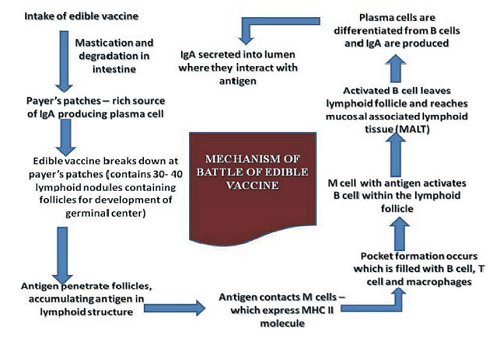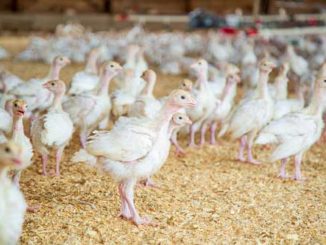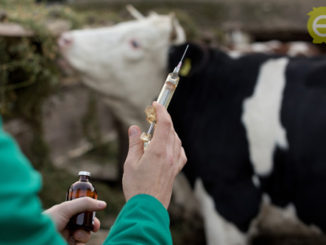Abstract
Edible vaccines mark a modern approach of oral immunization. The manufacturing process of a plant derived vaccine foremost involves the selection of the gene of interest. The target gene or the vaccine candidate is cloned into a plant expression system, efficient in promoting and terminating the expression of the transgene. The expression cassette is then delivered into a plant system for the production of the recombinant protein. Plant-based systems for production of recombinant therapeutic proteins have significant advantages over conventional expression systems. These advantages may include: lack of animal pathogens, minimal production costs, faster response time and rapid, dried leaves and seeds can be stored at room temperature for longer periods without any loss of recombinant protein; they would also not require storage and transportation under cold chain maintenance and could be administered in mass volumes with low level of processing. Several examples of plant derived vaccines developed for animal diseases are: plant cell culture-based vaccine for poultry against Newcastle disease virus (NCDV), edible potato-based vaccine against chicken Infectious Bronchitis virus (IBV), use of maize seeds as an edible delivery vehicle against porcine Transmissible gastroenteritis coronavirus (TGEV), plant-based subunit vaccine against Bovine viral diarrhea virus (BVDV). Edible vaccines may be seen in near future as a more safer and effective immunization method.
Introduction
Therapeutics always takes a back seat to preventive measure in a disease control program. Moreover, the world is facing a complex issue of antimicrobial resistance against many antibiotics due to their extensive and indiscriminate use as therapeutics. Vaccination has always been the most efficient method of disease prevention. Nowadays, alternative vaccine development and delivery strategies have covered up many limitations of conventional vaccines. Edible vaccines, the transgenic plant-derived vaccines are of great value especially with respect to vaccine administration and storage. These vaccines are prepared by plant molecular farming using genetic engineering. Edible vaccines are similar to sub-unit vaccines, in which the vaccine component is the antigen and contains no other genes that could lead to formation of the whole pathogen. Plants can express more than one transgene and therefore deliver more than one antigen at a time. The edible vaccines developed using plant based production systems can be consumed either directly or in processed form. These edible vaccines are administered orally, which may account for the disadvantage that it can be degraded by the acidic pH and gastric juices secreted by the GIT, but the cell wall of the plant cells helps to protect it from such GIT destruction. Different parts of plants such as leaf, stem, root, seeds, and fruit can be utilized for the expression of plant proteins as a vaccine candidate. Tobacco is the most common plant utilized for the expression of proteins due to its transforming ability. Edible vaccines have been developed for human and animal diseases such as Hepatitis B, FMDV, NCDV etc. (Saxena et al., 2005; Dus Santos and Wigdorovitz, 2005).
History of development of recombinant proteins using plant-based systems
The earliest was the production of human interferon alpha D in turnip by inoculating the mutant cauliflower mosaic virus carrying human interferon alpha D at its ORF II. Then the concept was also used for the production of many recombinant enzymes such as avidin, beta glucoronidase and trypsin. First commercialized plant-derived protein was the monoclonal antibody against HbsAg (Hepatitis B surface antigen) expressed in tobacco plant. A report on edible vaccine produced using surface protein from Streptococcus came in 1990 (Mason and Arntzen, 1995). Plant systems have been used for the expression of various vaccine candidates such as Norwalk virus particles, E. coli heat labile enterotoxin B subunit and V. cholerae toxin B (Pascual, 2007). The first plant based vaccine which was given the regulatory approval by United States Department of Agriculture, Center for Veterinary Biologics, was a poultry vaccine prepared against Newcastle disease virus (NDV) (Vermij and Waltz, 2006). Recently, plant based vaccine against SARS-CoV-2 using expression of spike (S1) protein were also developed, which have proceeded to clinical trials (Maharjan and Choe, 2021).
Preparation of edible vaccines
For the development of an edible vaccine, the first and the foremost step is the selection of the gene of interest from the pathogen against which the vaccine has to be produced. This gene of interest is incorporated into a suitable plant expression vector (Liew and Bejo, 2015). The expression vector is then delivered to the candidate plant where the protein expresses itself. A suitable plant for harboring the required gene, which should have competence for uptake of vector, long shelf life and easy growth requirements is selected to be a candidate plant such as tobacco, tomato and maize, etc. (Gunasekaran et al., 2020).
Methods for introduction of foreign DNA into plant’s genome
- Using Agrobacterium tumeifaciens : A naturally occurring soil bacterium, possesses a circular tumor inducing (Ti) plasmid which helps to incorporate the gene of interest into the plant’s genome (Mishra et al., 2008).
- Using biolistic method: The gene containing the DNA is coated onto the metal particles such as tungsten and gold and then it is fired into the plant cells with heavy bombardment using gene gun. The plant cells which take up the DNA are then grown in new plants and cloned.
- Using electroporation: The plant cells are treated with the enzyme for weakening of the cell wall. Then the plasma membrane is made porous by exposing the plant cells to high voltage electric current for a short period, which facilitates the incorporation of the foreign DNA into the plant cells (Singh, 2002).
- Using chimeric viruses: This utilizes the use of plant viruses genetically engineered to take up the foreign DNA and infect their natural plant hosts.
By any of the above mentioned methods, a large number of genetically identical crops producing desired protein as vaccine units are developed (Taylor and Fauquet, 2002; Maliga, 2002).
Mechanism of action of edible vaccines
Edible vaccines are capable of stimulating both the mucosal as well as humoral immunity of the body system (Jacob et al., 2013). Mucosal surface is the largest immunologically active tissue in our body (Tacket and Mason, 1999). Antigen which enters through the administered edible vaccine comes in contact with the M-cells present in the Peyer’s patches and the gut-associated lymphoid tissue. The association of the M-cell and the antigen triggers the activation of B-cells, which then differentiates into plasma cells and thereby releasing the specific antibodies against the antigen encountered. A flow chart representation has been included (Fig 1.)

Examples of some plant-based vaccines in the field of veterinary science
- Plant-derived poultry vaccine against Newcastle disease virus (NDV) was the first plant-based vaccine- approved by- the United States Department of Agriculture, Center for Veterinary Biologics. Maize was used to express the immunogenic glycoprotein of the New Castle disease virus. The vaccine shows 90% protection rate in chicken when challenged with the NDV (Liew and Bejo, 2015).
- An edible vaccine against the Transmissible gastroenteritis virus (TGEV) in pigs was the first patented edible vaccine whose efficacy has been tested in clinical trials. The corn plant was used to express the envelope spike protein of TGEV. The protective antibodies were observed to be induced both in piglets and gilts (Lamphear et al., 2004).
- A plant-based vaccine developed against the Infectious Bursal disease virus (IBDV) was also shown to confer protective immunity in the chickens in the challenge and protection studies. The rice seeds were used to express the VP2 protein of IBDV (Wu et al., 2007).
- It was observed experimentally that subcutaneous injection of F4 fimbriae adhesin protein of Enterotoxigenic coli in which barley grains was used as the plant for the expression of the protein induced neutralizing antibodies in mice (Joensuu et al., 2006).
Advantages of edible vaccines
- Storage of the vaccine product does not require the maintenance of the cold chain, hence easy store and storage can be done near the site of use with higher shelf life
- Plant matrix could provide some expression construct required for recombinant protein protection against the gastrointestinal harsh conditions (much better in plant seeds) – antigen protection through bioencapsulation
- Scaling up the production of recombinant proteins in transgenic plants is much easier and less costly
- Reduce the use of needles and cold chain for vaccine delivery
- Economical in relation to mass production and transportation
- Easier means of administration of vaccine
- Generation of systemic and mucosal immunity
- The delivery of multiple antigens is possible
Limitations of edible vaccines
- Stability of vaccine in fruit or any other plant product is not known
- Evaluating dosage requirement is tedious
- Selection of best plant for the protein expression is difficult
- Consistency of dosage from fruit to fruit, plant to plant and generation to generation is not similar
- Cooking requirement in some foods may weaken the antigen. Some plants require the process of cooking to be consumed, this may degrade or weaken the antigen present due to the high temperature
Conclusion
Edible plant derived vaccine may lead to a future of safer and effective immunization. They possess the potential to overcome the lacunas associated with traditional vaccines of production, distribution and delivery, etc. The benefits such as the easy and safe use, plus the cost effective production can provide preventive care to a larger population, especially in developing countries like India. The diseases like FMD, NCD, and IBD which causes severe impact on country’s economy can be controlled with edible vaccine at easier way than conventional vaccine strategies. A lot of research still needs to be done to study various aspects of vaccine development such as desired protein expression levels, prevention of proteolysis in plastids, dose calculation with respect to specific animal, side effects etc (Kurup and Thomas, 2020). Further study to develop these vaccines in plants like natural grasses/fodders for effortless vaccine delivery in animals and awareness of edible vaccines among the people are another important aspect.
References
- Dus Santos, M. J. and Wigdorovitz, A. 2005. Transgenic plants for the production of veterinary vaccines. Immunology and cell biology, 83(3), 229-238.
- Esmael H. and Hirpa E. 2015. Review on Edible Vaccine. Academic Journal of Nutrition, 4 (1), 40-49.
- Gunasekaran, B. and Gothandam, K.M. 2020. A review on edible vaccines and their prospects. Brazilian Journal of Medical and Biological Research e8749.
- Jacob S.S., Cherian S., Sumithra T.G., Raina O.K., Sankar M. 2013. Edible vaccines against veterinary parasitic diseases—Current status and future prospects. Vaccine. 31,1879– 1885.
- Joensuu J.J., Kotiaho M., Teeri T.H., Valmu L., Nuutila A.M., Oksman-Caldentey K., Teeri V.N. 2006. Glycosylated F4 (K88) Fimbral adhesion FaeG expressed in barley endosperm induces ETEC-neutralizing antibodies in mice. Transgenic research. 15, 359.
- Kurup, V. M., and Thomas, J. 2020. Edible vaccines: promises and challenges. Molecular biotechnology, 62(2), 79-90.
- Lamphear B. J., Jilka J. M., Kesl L., Welter M., Howard J. A., Streatfield S. J. “A corn-based delivery system for animal vaccines: an oral transmissible gastroenteritis virus vaccine boosts lactogenic immunity in swine,” Vaccine. 22(19), 2420–2424.
- Liew, P. S. and Hair-Bejo, M. (2015). Farming of plant-based veterinary vaccines and their applications for disease prevention in animals. Advances in virology, 2015.
- Maharjan, P. M., and Choe, S. 2021. Plant-based COVID-19 vaccines: current status, design, and development strategies of candidate vaccines. Vaccines, 9(9), 992.
- Maliga, P. (2002). Engineering the plastid genome of higher plants. Current opinion in plant biology, 5(2), 164-172..
- Mason H.S. and Arntzen C.J. 1995. Transgenic plant as vaccine production system.Trends Biotechnol. 13. 388-392.
- Mishra N., Gupta P.N., Khatri K., Goyal A.K. and Vyas S.P. 2008. Edible vaccines: A new approach to oral immunization. Indian Journal of Biotechnology. Vol 7, 283-294.
- Pascual, D. W. (2007). Vaccines are for dinner. Proceedings of the National Academy of Sciences, 104(26), 10757-10758.
- Saxena, R. K., Sheoran, A., and Pandit, G. L. (2005). How not to Interpret the Advances of Biotechnology. Philosophy in the Contemporary World, 12(1), 93-102.
- Singh, B., 2002. Biotechnolgy. Kalyani publishers. New Delhi, 1, 323.
- Tacket, C. O. and Mason, H. S. (1999). A review of oral vaccination with transgenic vegetables. Microbes and infection, 1(10), 777-783.
- Taylor, N. J. and Fauquet, C. M. (2002). Microparticle bombardment as a tool in plant science and agricultural biotechnology. DNA and cell biology, 21(12), 963-977.
- Vermij, P. and Waltz, E. (2006). USDA approves the first plant-based vaccine. Nat Biotechnol, 24(3), 234.
- Wu, J., Yu, L., Li, L., Hu, J., Zhou, J. and Zhou, X. (2007). Oral immunization with transgenic rice seeds expressing VP2 protein of infectious bursal disease virus induces protective immune responses in chickens. Plant Biotechnology Journal, 5(5), 570-578.








Be the first to comment